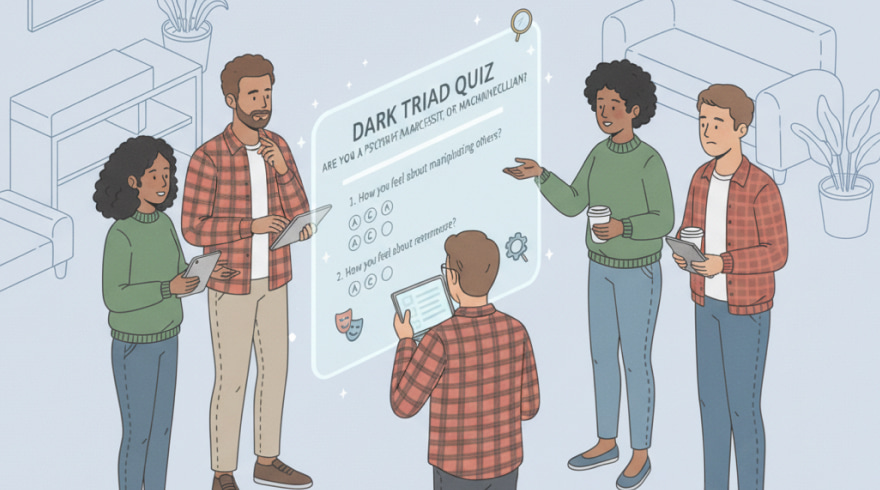Psychopathy Quizzes: Evidence, Benefits, and Cautions for Curious Readers
- 3 November 2025

What These Quizzes Are, What They Are Not, and Why Interest Keeps Rising
Online personality quizzes that screen for dark traits tap into a mix of curiosity, self-reflection, and pop-culture intrigue. People want language for patterns they notice in themselves or others: limited empathy, impulsivity, superficial charm, or a tendency to exploit. While the internet brims with quick tests and entertaining checklists, truly informative screenings borrow from peer-reviewed instruments, emphasize context, and avoid medical labels. The best resources treat results as informational rather than diagnostic and point users toward education, boundaries, and, when appropriate, professional guidance.
Many readers, long after watching a true-crime documentary or hearing a buzzy term at work, explore short assessments to better understand behavioral traits. In that spirit, some will try a psychopath test quiz to organize observations, compare them to research-backed dimensions, and benchmark tendencies against a wider population. Importantly, any single score tells only part of the story because personality sits on spectrums; traits cluster, shift with environments, and interact with upbringing, stress, and goals. Reliable quizzes frame results with nuance, explain limitations plainly, and encourage thoughtful next steps rather than alarmist conclusions.
Behind the scenes, careful assessments use neutral wording, balanced response options, and validity checks that minimize bias. Clear instructions, privacy-forward data handling, and realistic feedback further increase trust. When those basics are done well, a quiz becomes a springboard for self-knowledge: clarifying where empathy, risk tolerance, and impulse control shine, and where habits might benefit from recalibration. That blend of reflection and action is what keeps these tools compelling.
How Solid Screenings Work: Constructs, Methodology, and What to Expect
Effective psychopathy-oriented quizzes translate clinical constructs into everyday language without diluting scientific meaning. They typically sample multiple dimensions, affective empathy, interpersonal style, lifestyle regulation, and antisocial patterns, rather than chasing a single “type.” Items must be clear, specific, and resistant to social desirability bias. Response scales (for example, strongly disagree to strongly agree) allow gradations rather than yes/no binaries, and scoring aggregates patterns instead of fixating on a single answer. Good feedback contextualizes percentiles, explains typical behaviors associated with each range, and suggests practical, non-alarming steps for growth.
| Dimension | What it screens | Typical items | What results can mean |
|---|---|---|---|
| Affective empathy | Emotional resonance and concern | Reactions to others’ pain or distress | Lower scores may reflect detachment; higher scores suggest responsiveness |
| Interpersonal style | Charm, manipulation, grandiosity | Use of flattery, bending rules, attention-seeking | Elevations can signal exploitative tactics or image management |
| Impulse control | Planning, patience, delay of gratification | Spur-of-the-moment choices, boredom tolerance | Lower regulation correlates with risk-taking and inconsistency |
| Antisocial tendencies | Rule-breaking and harm without remorse | History of fights, deceit, property damage | Frequent occurrences raise concerns that warrant professional input |
| Conscientiousness balance | Order, reliability, goal focus | Meeting deadlines, following through | Higher orderliness can buffer against rash decisions |
Because context matters, robust tools disclose their development: sample sizes, demographics, reliability coefficients, and how items map to recognized frameworks. Brief explanations of false positives and base-rate fallacies help users interpret elevated scores prudently. Clear caveats are not a scare tactic, they are quality markers that distinguish a thoughtful screening from a viral curiosity.
- Look for transparent scoring and plain-language descriptions.
- Prefer tools that acknowledge limits and provide evidence sources.
- Value guidance that emphasizes safe, practical actions over labels.
Benefits of Taking a Quiz and Using the Insights Responsibly
When approached thoughtfully, short screenings offer practical payoffs without sensationalism. Self-knowledge helps people spot patterns that impact relationships, decision-making, career fit, and stress management. The reflection can clarify boundaries, highlight strengths, such as composure under pressure, and illuminate vulnerable habits like thrill-seeking or chronic rule-bending. With that clarity, it becomes easier to plan micro-changes that compound over time, from setting response delays before big choices to practicing perspective-taking during conflict.
Cost and convenience matter too, especially for first-time explorers who are testing the waters. For many, discovering a free psychopath test quiz lowers the barrier to entry while still providing structured feedback and actionable suggestions. The key is to favor sources that explain privacy policies, avoid exaggerated claims, and recommend follow-up resources when scores raise red flags. Turning curiosity into constructive behavior change is far more valuable than chasing a label.
- Translate results into one small weekly behavior experiment.
- Invite feedback from trusted peers about a single habit you are adjusting.
- Track outcomes with simple notes: trigger, choice, effect, lesson.
Ethical use also means resisting armchair diagnosis. These quizzes are educational tools, not clinical evaluations. Treat results as conversation starters, not verdicts, and remember that context, sleep, stress, substance use, or environment, can nudge scores up or down. Responsible interpretation keeps curiosity productive and respectful.
Interpreting Scores, Avoiding Pitfalls, and Navigating Next Steps
Reading a score is only the start; meaning emerges when you connect patterns to real-life choices. Percentiles simply locate you on a distribution, not on a moral scale. If a dimension runs high, look for the specific behaviors that drive it, then craft small experiments that redirect those behaviors toward healthier outcomes. If a dimension runs low, identify contexts where that trait is valuable and practice calibrated stretches. Nuance beats absolutism every time, especially when traits trade off with one another in complex environments.
Because dark traits overlap with neighboring constructs, cross-referencing can deepen understanding without conflation. Some users, for instance, compare results with a narcissistic test quiz to differentiate interpersonal grandiosity from broader callousness or impulsivity. That comparison should clarify boundaries rather than blur them, and it should be grounded in careful definitions and consistent language. When uncertainty persists, a consultation with a licensed professional can provide structured evaluation, richer context, and tailored recommendations.
- Document two specific situations per week where a targeted trait appears.
- Choose one replacement behavior in advance and rehearse it briefly.
- Review progress monthly, adjusting goals in light of actual outcomes.
Finally, protect your data. Use quizzes that minimize personal information, allow anonymous results, and avoid selling responses to third parties. Psychological information is sensitive; treat it like any other valuable asset and favor creators who respect your autonomy.
Frequently Asked Questions
Are these quizzes diagnostic or medical tools?
No. They are educational screenings that point to patterns worth exploring, not clinical instruments that establish a diagnosis. Only a qualified professional can evaluate history, context, and collateral information to form a clinical judgment.
What makes a quiz scientifically credible?
Credible tools publish evidence: how items were created, tested, and refined; reliability and validity statistics; and sample diversity. They also provide balanced feedback that explains strengths, risks, and limitations in everyday language.
How should I act on a high score in a specific dimension?
Translate the insight into a small, testable behavior change. For example, add a pause before major decisions, solicit input from a trusted friend, and track outcomes for two weeks. Iteration matters more than intensity.
Can results change over time?
Yes. While core tendencies can be stable, behaviors shift with age, stress, sleep, relationships, and practice. Retesting after meaningful lifestyle changes can reveal helpful trends, especially when you record consistent contexts.
Is it appropriate to evaluate other people using online quizzes?
Use caution. Assigning labels to others without consent or formal assessment risks misunderstanding and harm. If safety or well-being is at stake, seek professional support rather than relying on informal screenings.
Latest News
-
![Comprehensive Guide to Sociopathy Self-Assessments and Quizzes]()
- 10 November, 2025
-
![A Complete Guide to Understanding the Dark Triad Quiz]()
- 7 November, 2025
-
![The Guide to Narcissism Self-Assessments: Insights, Benefits, and Smart Next Steps]()
- 6 November, 2025



